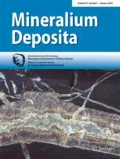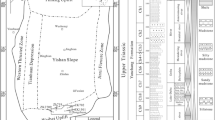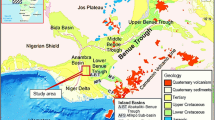Abstract
A significant resource of vanadium and molybdenum exists near Julia Creek, Australia, where the middle Cretaceous organic-rich Toolebuc Formation lies between 0 and 25 m of the surface. We present and discuss a comprehensive geochemical study of the Toolebuc Formation and its enclosing stratigraphy near Julia Creek to understand this ore deposit. V and Mo contents in fresh facies are strongly associated with total organic carbon (TOC) contents, but not with Al or CaCO3; this suggests that V and Mo were originally concentrated in the organic fraction. However, chemical extractions using H2O2 indicate that Mo was originally concentrated in pyrite. The data also suggest that V was mobilised from organic matter during early diagenesis and became associated with clays as little V was extracted by H2O2 in the fresh samples. TOC contents in the Toolebuc Formation were removed during weathering, residually enriching trace metals including V and Mo, and as a result, the TOC relationship with V and Mo disintegrates. With weathering, both V and Mo predominantly became associated with iron oxide/hydroxide phases (and possibly other unidentified phases) as these elements in the weathered facies were highly soluble in the sodium citrate–sodium dithionite digestion. Large shale-hosted V and Mo deposits such as Julia Creek offer a potentially viable alternative to the currently mined magnetite-hosted deposits. A thorough understanding of the formation and host mineral phases for V and Mo of these shale deposits, however, is critical to ensure that these valuable metals can be feasibly extracted.








Similar content being viewed by others
References
Al-Madfa H, Abdel-Moati MAR, Al-Gimaly FH (1998) Pinctada radiate (pearl oyster): a bioindicator for metal pollution monitoring in the Qatari Waters (Arabian Gulf). Bull Environ Contam Toxicol 60:245–251
Amiard J-C, Journel R, Bacheley H (2008) Influence of field and experimental exposure of mussels (Mytilus sp.) to nickel and vanadium on metallothionein concentration. Comp Biochem Physiol C 147:378–385
Belzile N, Lebel J (1986) Capture of arsenic by pyrite in near-shore marine sediments. Chem Geol 54:279–281
Bertine KK (1972) The deposition of molybdenum in anoxic waters. Mar Chem 1:43–53
Boening DW (1999) An evaluation of bivalves as biomonitors of heavy metals pollution in marine waters. Environ Monit Assess 55:459–470
Coxhell S, Fehlberg B (2000) Julia Creek vanadium and oil shale deposit. NQEM 2000 Symposium, Townsville, April 2000, pp. 1–15
Dale LS, Fardy JJ (1983) Trace element characterization of Australian oil shales. Proceedings of the First Australian Workshop on Oil Shale Lucas Heights, 18–19th May 1983, Sydney, pp 57–60
Exon NF, Senior BR (1976) The Cretaceous of the Eromanga and Surat Basins. BMR J Aust Geol Geophys 1:33–50
Frakes LA, Burger D, Anthrope M, Wiseman J, Dettmann M, Alley N, Flint R, Gravestock D, Ludbrooke N, Backhouse J, Skwarko S, Scheibnerova V, McMinn A, Moore PS, Bolton BR, Douglas JG, Christ R, Molnar WM, RE McGowran B, Balme BE, Day RA (1987) Australian Cretaceous shorelines, stage by stage. Palaeogeogr Palaeoclimatol Palaeoecol 59:31–48
Gleason JD, Moore TC, Rea DK, Johnson TM, Owen RM, Blum JD, Hovan SA, Jones CE (2002) Ichthyolith strontium isotope stratigraphy of a Neogene red clay sequence: calibrating eolian dust accumulation rates in the central North Pacific. Earth Planet Sci Lett 202:625–636
Glikson M, Taylor GH (1986) Cyanobacterial mats: major contributions to the organic matter in Toolebuc Formation oil shales. In: Gravestock DI, Moore PS, Pitt GM (eds) Contributions to the geology and hydrocarbon potential of the Eromanga Basin. Geological Society of Australia Special Publication 12, pp 255–265
Glikson M, Chappell BW, Freeman RS, Webber E (1985) Trace elements in oil shales, their source and organic association with particular reference to Australian deposits. Chem Geol 53:155–174
Goldberg S, Forster HS, Godfrey CL (1996) Molybdenum absorption on oxides, clay minerals, and soils. J Am Soil Sci Soc 60:425–432
Hansley PL, Spirakis CS (1992) Organic matter diagenesis as the key to a unifying theory for the genesis of tabular uranium–vanadium deposits in the Morrison Formation, Colorado Plateau. Econ Geol 87:352–365
Henderson RA (1998) Palaeoenvironmental and eustatic record of mid-Cretaceous Bathurst Island Group, Money Shoals Platform, northern Australia. Palaeogeogr Palaeoclimatol Palaeoecol 138:115–138
Henderson RA (2004) A mid-Cretaceous association of shell beds and organic-rich shale: bivalve exploitation of a nutrient-rich, anoxic sea-floor environment. Palaios 19:156–169
Henderson RA, Kennedy WJ (2002) Occurrence of Goodhallites goodhalli J. Sowerby (Ammonoidea) in the Eromanga Basin: an index species for the late Albian (Cretaceous). Alcheringa 26:233–247
Henderson R, Crampton J, Dettmann M, Douglas J, Haig D, Shafik S, Stilwell J, Thulborn T (2000) Biogeographical observations on the Cretaceous biota of Australasia. In: Wright AJ, Young GC, Talent JA Laurie JR (eds) Palaeobiogeography of Australasian faunas and floras. Memoir of the Association of Australian Palaeontologists 23, pp 355–404
Hewett DF (1909) Vanadium deposits in Peru. Trans Am Inst Min Eng 40:274–299
Hirner AV, Xu Z (1991) Trace metal speciation in Julia Creek oil shale. Chem Geol 91:115–124
Intermin Resources Ltd (2007) Announcement: vanadium/molybdenum resource update Julia Creek Project Queensland, 6 September 2007
Kucha H, Mayer W, Piestrzynski A (1983) Vanadium in the copper ore deposit on the Fore-Sudetic Monocline (Poland). Mineral Pol 14:35–43
Lewan MD, Maynard JB (1982) Factors controlling enrichment of vanadium and nickel in the bitumen of organic sedimentary rocks. Geochim Cosmochim Acta 46:2547–2560
Lewis S.E (2000) Sedimentology and geochemistry of the Julia Creek vanadium deposit, Toolebuc Formation (Albian), Great Artesian Basin. BSc (honours) thesis, James Cook University, 110 pp
McKelvey VE, Strobell JD, Slaughter AL (1986) The vanadiferous zone of the Phosphoria Formation in Western Wyoming and Southeastern Idaho. US Geological Survey Professional Paper 1465, 27 pp
Moore PS, Pitt GM, Dettmann ME (1986) The Early Cretaceous Coorikiana Sandstone and Toolebuc Formation: their recognition and stratigraphic relationship in the southwestern Eromanga Basin. In: Gravestock DI, Moore PS, Pitt GM (eds) Contributions to the geology and hydrocarbon potential of the Eromanga Basin. Geological Society of Australia Special Publication 12, pp 97–114
Morse JW, Luther GW (1999) Chemical influences on trace metal–sulfide interactions in anoxic sediments. Geochim Cosmochim Acta 63:3373–3378
Mueller G, Gastner M (1971) The “Karbonate-bombe”: a simple device for the determination of the Ka carbonate content in sediments, soils and other materials. Neves Jahrbuch fuer Mineralogie 10:466–469
Norrish K, Patterson JH (1976) Characterization of vanadiferous clays, Julia Creek, Queensland. Symposium 104.2, 25th Geological Congress, Sydney Geological Congress. Geological Society of Australia Abstracts 3, pp 756–757
Olsen SN, Grant JA (1991) Isocon analysis of migmatization in the Front Range, Colorado, USA. J Metamorph Geol 9:151–164
Ozimic S (1986) The geology and petrophysics of the Toolebuc Formation and its time equivalents, Eromanga and Carpentaria Basins. In: Gravestock DI, Moore PS, Pitt GM (eds) Contributions to the geology and hydrocarbon potential of the Eromanga Basin. Geological Society of Australia Special Publication 12, pp 119–137
Patterson JH, Ramsden AR, Dale LS, Fardy JJ (1986) Geochemistry and mineralogical residences of trace elements in oil shales from Julia Creek, Queensland, Australia. Chem Geol 55:1–16
Peacor DR, Coveney RM, Zhao G (2000) Authigenic illite and organic matter: the principal hosts of vanadium in the Mecca Quarry Shale at Velpen, Indiana. Clays Clay Miner 48:311–316
Petsch ST, Berner RA, Eglinton TI (2000) A field study of the chemical weathering of ancient sedimentary organic matter. Org Geochem 31:475–487
Pevear DR, Grabowski GJ (1985) Geology and geochemistry of the Toolebuc Formation, an organic-rich chalk from the Lower Cretaceous of Queensland, Australia. In: Crevello PD, Harris PM (eds) Deep water carbonates: buildups, turbidites, debris flows and chalks—A core workshop. SEPM Core Workshop No. 6, New Orleans, March 23–24 1985, pp 303–341
Premovic PI, Pavlovic MS, Pavlovic NZ (1986) Vanadium in ancient sedimentary rocks of marine origin. Geochim Cosmochim Acta 50:1923–1931
Quinby-Hunt MS, Wilde P (1994) Thermodynamic zonation in the black shale facies based on iron–manganese–vanadium content. Chem Geol 113:297–317
Quinby-Hunt MS, Wilde P (1996) Chemical depositional environments of calcic black shales. Econ Geol 91:4–13
Riley KW, Saxby JD (1982) Association of organic matter and vanadium in oil shale from the Toolebuc Formation of the Eromanga Basin. Chem Geol 37:265–275
Riley KW, Saxby JD (1986) Organic matter and vanadium in the Toolebuc Formation, northern Eromanga Basin and southern Carpentaria Basin. In: Gravestock DI, Moore PS, Pitt GM (eds) Contributions to the geology and hydrocarbon potential of the Eromanga Basin. Geological Society of Australia Special Publication 12, pp 267–272
Sherwood NR, Cook AC (1986) Organic matter in the Toolebuc Formation. In: Gravestock DI, Moore PS, Pitt GM (eds) Contributions to the geology and hydrocarbon potential of the Eromanga Basin. Geological Society of Australia Special Publication 12, pp 255–265
Taylor JC (1991) Computer programs for standardless quantitative analysis of minerals using the full powder diffraction profile. Powder Diffr 6:2–9
Tourtelot HA (1979) Black shale—its deposition and diagenesis. Clays Clay Miner 27:313–321
Turkekian KK, Wedepohl KH (1961) Distribution of the elements in some major units of the Earth’s crust. Geol Soc Am Bull 72:175–192
Van Oorschot IHM, Dekkers MJ (1999) Dissolution behaviour of fine-grained magnetite and maghemite in citrate–bicarbonate–dithionite extraction method. Earth Planet Sci Lett 167:283–295
Webb AD, Dickens GR, Oliver NHS (2003) From banded iron-formation to iron ore: geochemical and mineralogical constraints from across the Hamersley Province, Western Australia. Chem Geol 197:215–251
Acknowledgements
We thank Fimiston Resources NL for supporting this project. The study was also partially funded by an Australian Research Council grant to RAH (grant A39933019). Staff of the Zillmere core storage facility of the Queensland Department of Natural Resources and Mines are thanked for their assistance in making cores available for inspection. We thank Steve Hovan for supplying the sodium citrate–sodium dithionite method. We are grateful to the skilled staff at the Advanced Analytical Centre, James Cook University for their assistance in the XRF, XRD and ICP analyses, particularly to Dr Yi Hu, Dr Elvy Grigolato and Mr Alan Chappell. We thank Dr Enrico Mocellin at the Chemical and MicroAnalytical Services Pty. Ltd laboratory for total carbon analysis. The comments from three anonymous reviewers and Gary Davidson greatly improved the manuscript.
Author information
Authors and Affiliations
Corresponding author
Additional information
Editorial handling: G. Davidson
Electronic supplementary material
ESM 1
(XLS 456 kb)
Rights and permissions
About this article
Cite this article
Lewis, S.E., Henderson, R.A., Dickens, G.R. et al. The geochemistry of primary and weathered oil shale and coquina across the Julia Creek vanadium deposit (Queensland, Australia). Miner Deposita 45, 599–620 (2010). https://doi.org/10.1007/s00126-010-0287-6
Received:
Accepted:
Published:
Issue Date:
DOI: https://doi.org/10.1007/s00126-010-0287-6




